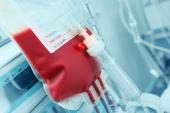Diltiazem and DOAC Interaction Increases Bleeding Risk in AF
Physicians have adopted a one-size-fits-all approach to direct oral anticoagulants that must be reconsidered, says Geoffrey Barnes.

A drug-drug interaction between the calcium channel blocker diltiazem and two commonly prescribed direct oral anticoagulants (DOACs) may increase the risk of serious bleeding events in patients with atrial fibrillation (AF), a large study of Medicare patients suggests.
Compared with AF patients on beta-blocker therapy with metoprolol for ventricular rate control, those on diltiazem had more bleeding-related hospitalizations and a higher risk of death with recent evidence of bleeding when concomitantly using apixaban (Eliquis; Bristol Myers Squibb) or rivaroxaban (Xarelto; Bayer/Janssen).
“The absolute risk of serious bleeding associated with diltiazem treatment increased with diltiazem doses higher than 120 mg/d; increased HAS-BLED score, which summarizes common risk factors for anticoagulant-related hemorrhage; and rivaroxaban use, which has been consistently associated with rates of serious bleeding greater than those for other direct oral anticoagulants,” write Wayne A. Ray, PhD (Vanderbilt University School of Medicine, Nashville, TN), and colleagues in the paper published in JAMA.
They suggest that measures to reduce the clinical impact of the interaction should target particularly high-risk patients, “including those with advanced age, history of bleeding, pro-hemorrhagic medication use, or rivaroxaban use.” In prior work, Ray et al had demonstrated that being on rivaroxaban was associated with greater risk for bleeding than apixaban in those with AF.
Commenting for TCTMD, Geoffrey Barnes, MD (University of Michigan, Ann Arbor), said it is known that apixaban and rivaroxaban interact with several drugs through the hepatic cytochrome P450-3A4 (CYP3A4) pathway and the permeability glycoprotein pathway, although most of those interactions are with less commonly prescribed agents like anti-epileptic medications, antifungals, and antivirals.
We have been using these medicines for more than a decade now in a kind of a one-size-fits-all approach. Geoffrey Barnes
The new data, he added, should also spark conversations about personalizing therapy based on shared decision-making.
“In some patients, if you need to use a [ventricular] rate controlling agent, you might be able to use metoprolol instead of diltiazem and then say to the patient, we can still use one of the more commonly used anticoagulants,” Barnes suggested. “Other patients may get side effects from metoprolol, or it may not be a good drug for them and then in that case it's going to be a question of: do we use a different anticoagulant?”
Warfarin would be one obvious choice, with another being dabigatran (Pradaxa; Boehringer Ingelheim), which acts independent of CYP3A4, Barnes specified. An additional option may be patient acceptance of bleeding risk with diltiazem based on preference or insurance coverage limitations within a shared decision discussion.
Ray and colleagues note that despite the findings, many AF patients with elevated risk of hemorrhage likely will continue to receive diltiazem with DOACs because it is their best option—in those patients, they say, therapeutic drug monitoring might be warranted.
Questions About Other Agents
For the study, Ray and colleagues analyzed data from 204,155 Medicare beneficiaries (mean age 76.9 years; 52.7% female) with AF who were receiving a DOAC for stroke prevention and were also taking diltiazem (n = 53,275) or metoprolol (n = 150,880).
Risk for the primary outcome (bleeding-related hospitalization or death with a recent bleeding event) was increased in the diltiazem group compared with the metoprolol group (HR 1.21; 95% CI 1.13-1.29).
Compared with the metoprolol patients, the diltiazem group also saw increased risk of the individual endpoints of bleeding-related hospitalization (HR 1.22; 95% CI 1.13-1.31) and death with recent bleeding (HR 1.19; 95% CI 1.05-1.34), but no differences were seen for ischemic stroke or systemic embolism, major ischemic or hemorrhagic events, or death with no recent evidence of bleeding.
By dose, the risk was highest in those on more than 120 mg/day of diltiazem (HR 1.29; 95% CI 1.19-1.39) compared with lower doses (HR 1.13; 95% CI 1.14-1.24). The high-dose group also had elevated risks of major ischemic or hemorrhagic events (HR 1.14; 95% CI 1.02-1.27).
The difference between the adjusted incidence rates for diltiazem and metoprolol in patients with HAS-BLED scores of 1 or 2 was 9.8 per 1,000 person-years and 22 per 1,000 person-years for scores of 4 or higher. For apixaban patients, the difference between the adjusted incidence rates was 12 per 1,000 person-years, with a higher rate of 21.2 per 1,000 person-years for rivaroxaban patients.
Sensitivity analyses confirmed a higher risk for the primary composite outcome in those receiving high-dose diltiazem compared with low-dose therapy (HR 1.14; 95% CI 1.02-1.26).
While the study is limited by its nonrandomized design and inclusion of only Medicare beneficiaries, who are aged 65 years or older with both fee-for-service coverage and Medicare Part D, Barnes said it is large and robust enough to support the drug-drug interaction conclusion.
“This is about as strong of a study related to drug-drug interactions as we ever get, so for that reason, I think as clinicians, we're now going to have to think about what it means,” he added. “Some clinicians may look at this study and say, ‘Well, if I need to use diltiazem and it's inhibiting the breakdown of my anticoagulant apixaban or rivaroxaban, then maybe I should just reduce the dose to try and offset that.’ I would strongly caution against that thinking. This study did not test that. We have no data to tell us how much of a reduction would be appropriate and still provide the stroke prevention benefits.”
Additionally, Barnes said the study also raises questions about other drugs that have dual CYP3A4 and permeability glycoprotein pathway activity and whether they too may be impeding safe use of DOACs.
L.A. McKeown is a Senior Medical Journalist for TCTMD, the Section Editor of CV Team Forum, and Senior Medical…
Read Full BioSources
Ray WA, Chung CP, Stein CM, et al. Serious bleeding in patients with atrial fibrillation using diltiazem with apixaban or rivaroxaban. JAMA. 2024;Epub ahead of print.
Disclosures
- This study was supported by a grant from the National Heart, Lung, and Blood Institute.
- Ray reports receiving a grant from the National Institutes of Health during the conduct of the study.
- Barnes reports consulting for Bristol-Myers Squibb, Pfizer, and Janssen; and serving on the board of directors for the Anticoagulation Forum, which publishes drug-drug interaction lists.





Comments